There are 40 types of turtles in Georgia which include freshwater aquatic turtles, box turtles, tortoises, and even sea turtles.
Among these, the Loggerhead sea turtle, a species protected under the Endangered Species Act, is a notable visitor of Georgia’s coast, especially on the sandy beaches of barrier islands like Jekyll Island and Cumberland Island.
Georgia is a state that is rich in turtle diversity and a place where turtle lovers can go and explore in nature. The Georgia Department of Natural Resources plays an important role in the conservation efforts for these species, focusing on natural habitats including the coastal Georgia regions and the state’s barrier islands.
Not all turtle species are good as pets, but many of them can be. If you are looking for a pet turtle (aquatic or land) or tortoise you should never take them from the wild.
Check our adoption page to see who is giving up their pet.
Explore the diverse species of sea turtles and other turtles found in Georgia, where conservation measures under federal law and efforts by organizations like the Georgia Sea Turtle Center are crucial for their protection.
Table of Contents
Types of Turtles in Georgia
1. Bog Turtle

- Experience Level: Beginner
- Family: Emydidae
- Scientific Name: Glyptemys muhlenbergii (formerly Clemmys muhlenbergii)
- Common Name: Muhlenberg’s Turtle
- Adult Size: 4 inches on average
- Weight: averages at 300 pounds
- Lifespan: 30 years minimum, oldest recorded at 61 years
- Conservation Status: Critically Endangered
- Habitat: meadows, bogs, fens, open shrubby swamp, small streams
- Clutch Size: 3 to 4 clutches, 1 to 6 eggs per clutch
- Food: Omnivore; small vertebrates, invertebrates, fruits, seeds, grass, shrubs
- Appearance: dark olive-green or black with bright red, yellow, or orange blotch
The Bog Turtle is North America’s smallest turtle. The largest spotted bog turtle is only 4.5 inches.
Bog turtles live in mountain bogs and muddy, mossy wetlands. But this semi-aquatic turtle is not found in highly acidic bogs. They will typically choose meadows and fens (flooded area of land) with vegetation as a habitat.
Bog turtles are critically endangered which has been caused by their habitat destruction. Unfortunately their wild population has declined to serious levels at this point.
To address this issue, Georgia is running a Bog Turtle Headstart program in an effort to deal with this problem. The program gathers egg-bearing females to hatch their eggs in captivity.
They are released after two years when they reach adult size. That’s quite impressive since wild bog turtles can take 6 to 8 years to reach their adult size.
Bog turtles are typically active in Spring, early Summer, and fall. For hibernation over winter they will hide in burrows or mucky soil.
They love to bask on top of clumped vegetation. Interestingly, they also use clump vegetation to incubate their eggs.
2. Florida Softshell Turtle (Apalone Ferox)
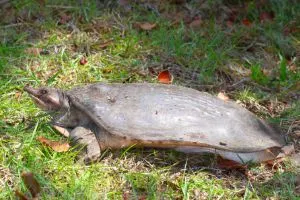
- Experience Level: Intermediate to Expert
- Family: Trionychidae
- Scientific Name: Apalone Ferox
- Adult Size: males at 6 to 12 inches and females at 11 to 24 inches
- Lifespan: 20 years
- Average Price Range: $69 to $279
- Recommended Book: Softshell Turtle Pet Owners Guide by Ben Team
You can definitely spot Florida softshell turtles in Georgia, particularly in the southern part. This large and flat softshell turtle is the bulkiest of its kind. They can weigh up to 96 pounds.
Females grow bigger than males. They have shorter tails, while males have longer ones. These turtles have tubular and pig-like noses.
3. Eastern Spiny Softshell Turtle (Apalone Spinifera)
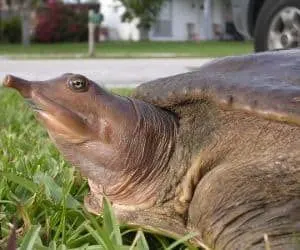
- Experience Level: Intermediate to Expert
- Family: Trionychidae
- Scientific Name: Apalone Spinifera, also Apalone Spinifera Hartwegi
- Adult Size: females at 21 inches, males at 8.5 inches
- Lifespan: 30 years
- Average Price Range: $59 to $279
- Recommended Book: Softshell Turtle Pet Owners Guide by Ben Team
These turtles are also commonly called Spiny Softshell Turtles and have a high reproductive rate. They can be found in large rivers, small ponds and creeks.
Habitat wise they like to be near vegetation and can be seen frequently basking on mudbanks or sand bars.
These oval-shaped turtles frequent rivers and ponds that have sandy bottoms which helps them blend in thanks to their sandy and tan color. As they get older their dark brown to black spots will fade.
Spiny Softshells have soft-edged shells and spines either on the front or back part. Others may have some more spines on the shell itself. They also have long necks and snorkel-like noses.
Diet wise they are mainly carnivorous and will eat fish, insects, invertebrates, and some vegetation.
If you own a hatchling, you can give it small insects like roaches, snails, and crickets. Good-quality pellets can give your turtle a balanced diet.
Remember not to handle your pet softshell while feeding or soon after feeding. It might mistake your finger as food and give you a nasty bite.
Eastern Spiny Softshell Turtles, like other Softshells, are best for experienced reptile pet owners. These may not be as aggressive as the Florida softshell, but overall, they need complex care.
4. Common Snapping Turtle (Chelydra Serpentina)
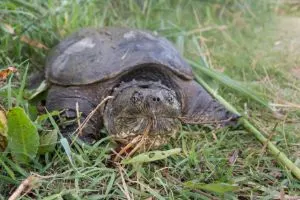
- Experience Level: Intermediate to Expert
- Family: Chelydridae
- Scientific Name: Chelydra Serpentina
- Adult Size: males up to 19.5 inches, females up to 14.4 inches
- Lifespan: 25 to 30 years, longest at 40 years
- Average Price Range: $24 to $59
- Recommended Book: Snapping Turtle Pet Owners Guide. The Captive Care of Snapping Turtles. Including Snapping Turtles Biology, Behavior and Ecology by Ben Team
Common snapping turtles are widely distributed locally and largely exported from the US to East Asia for their meat and blood.
You can spot these turtles in rivers, lakes, streams, creeks, or reservoirs around Georgia. Snapping turtles have tails that grow as long as their shells. The tails have saw-toothed keels.
They will have a dark colored head usually and their shells can be dark brown to tan in color while some others have black carapace. Their plastrons are quite small, so the extremities are exposed. You can also see some tubercles on the legs and neck which help them to sense water environmental changes.
They can weigh as much as 35 pounds and have an average lifespan in the wild of around 30 years.
Snapping turtles are not sociable and are among some of the most aggressive turtles.
When hunting, these turtles have a habit of burying themselves and leaving only the nostrils and eyes exposed to ambush their prey.
Snapping turtles love to be in water, so if you plan to keep one as a pet you need to make sure to have a large space or pond where there is some depth allowing them to swim and burrow comfortably.
5. Alligator Snapping Turtle

- Experience Level: Beginner
- Family: Chelydridae
- Scientific Name: Macrochelys temmincki
- Adult Size: 26 inches on average, longest at 30 inches carapace length
- Weight: up to 200 pounds
- Lifespan: 20 to 70 years
- Conservation Status: Vulnerable Worldwide
- Habitat: mostly aquatic, lives in rivers, lakes, and wetlands
- Average Price Range: Between $28 to $60
- Clutch Size: 1 clutch yearly, 8 to 52 eggs
- Food: mostly carnivore; fish, other reptiles, insects, mollusks, some plants, roots, and seeds or grain
- Appearance: looks like a dinosaur, 3 ridges from front to back of their shell, with scaly tails
Alligator Snapping Turtles are the largest among freshwater turtles in Georgia. They get as big as 200 pounds with carapace lengths exceeding 30 inches.
With their large size, it’s no surprise that they are very powerful. They also have strong beak-like jaws, and if you are not careful, one of these majestic reptiles can easily bite off one of your fingers or do some serious damage.
These turtles have a prehistoric look which is almost dinosaur-like. They have a spiked shell and a thick tail with scales. Their eyes are not the same as other snapping turtles. Theirs are on the sides of their head.
They have a habit of staying motionless in the water for long periods, that is why thick algae grow on their shells. They can even go for 50 minutes without coming up for air.
They use their tongues to lure in prey and then strike once the fish are nibbling on it. This is why they are known as ambush predators.
Alligator Snapping Turtles live for a long time, but they reproduce at a very low rate. Native to the United States, you can find them along rivers that flow into the Gulf of Mexico. These turtles live along reservoirs and populations of them can be found west of the Choctawhatchee River.
Alligator snapping turtles used to be one general species named Macrochelys temmincki but was later split into 3.
- Alligator Snapper (Macrochelys temminckii)
- Apalachicola Alligator Snapping Turtle (Macrochelys apalachicolae)
- Suwannee Alligator Snapping Turtle (Macrochelys suwanniensis)
One of two new species is the Apalachicola Alligator Snapping Turtle (Macrochelys apalachicolae) and is found between the Choctawhatchee and Ochlockonee River in Georgia, including Florida and Alabama.
The other is the Suwannee Alligator Snapping Turtle (Macrochelys suwanniensis), which can only be spotted in the Suwannee River Drainage in Georgia and Florida.
The distinguishing feature of Suwannee Alligator Snapping Turtles is their very wide and crescent-shaped caudal notch.
6. Eastern Painted Turtle (Chrysemys Picta Picta)
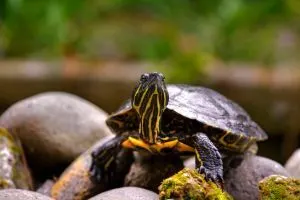
- Experience Level: Beginner
- Family: Emydidae
- Scientific Name: Chrysemys Picta Picta
- Adult Size: 4.5 to 6 inches
- Lifespan: 25 to 50 years
- Average Price Range: $79 to $209
- Recommended Book: Painted Turtle Care. Painted Turtle Pet Owners Guide. Painted Turtle care, behavior, diet, interacting, costs and health by Ben Team
Painted Turtles are widespread in the USA, and these are categorized as Eastern, Southern, Western, and Midland Painted Turtles.
You can spot Eastern Painted Turtles from Nova Scotia to Northern Georgia. These semi-aquatic turtles frequent shallow and vegetated wetlands, ponds, and slow-moving waterways.
Eastern Painted Turtles are oval, flat, and smooth-shelled turtles. They are keelless and have olive to black carapace and skin.
They may have yellow to red borders and a red crescent or bar marks on the marginal scutes and their plastron will be yellowish with no patterns. They also have yellow or red stripes on the legs, tails, and neck area.
You’ll see a yellow line running down the back from below their eyes. And similar patterns may be found at the lower jaw.
These Painted Turtles are great beginner pets because they are low maintenance. And you can easily set up a tank for these small turtles.
They are highly active and are excellent swimmers, so a spacious tank will be great for them.
7. Western Painted Turtle
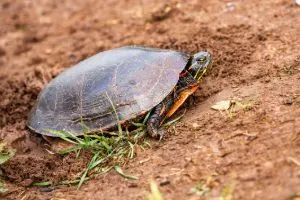
- Experience Level: Beginner
- Family: Emydidae
- Scientific Name: Chrysemys Picta Belli
- Common Name: Painted Turtle
- Adult Size: 4 to 10 inches
- Weight: between 300 grams to 500 grams
- Lifespan: 25 to 30 years, some painted turtles reach over 40 years
- Conservation Status: Least Concern
- Habitat: mostly aquatic, also terrestrial, shallow, slow-moving streams and ponds
- Average Price Range: Between $90 to $130
- Clutch Size: 2 clutches on average, 8 to 10 eggs per clutch
- Food: omnivorous; insects, snails, shrimps, plants, seeds, fruit
- Appearance: blackish or olive green carapace, distinct and bright orange palette or color mix on the belly
- Recommended Books: Painted Turtle care, behavior, diet, interacting, costs and health by Ben Team
The Western Painted Turtle is the largest painted turtle among other subspecies. You can easily identify the Western Painted Turtle by looking at the plastron.
It doesn’t have a solid color, unlike the Southern Painted Turtle, rather, it has a beautiful, colorful mix, with black blotches and shades on its plastron.
Pet painted turtles, including the Western Painted Turtles, are easy to feed. Give them earthworms, crickets, and even cooked chicken occasionally.
An adult diet includes kale and lettuce, as well as fruits like apples, berries, and carrots.
8. Southern Painted Turtle (Chrysemys Picta Dorsalis)
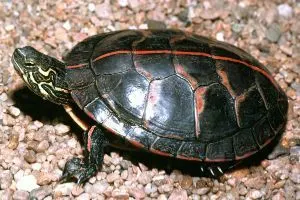
- Experience Level: Beginner
- Family: Emydidae
- Scientific Name: Chrysemys Picta Dorsalis
- Adult Size: 3.5 to 7 inches
- Lifespan: 25 to 50 years
- Average Price Range: $64 to $139
- Recommended Book: Painted Turtle care, behavior, diet, interacting, costs and health by Ben Team
Of all four types of Painted Turtles, the Southern Painted Turtle is the smallest, and many find it the most attractive, too.
You can spot them in the slow-moving freshwater systems around Georgia. They chose areas with lots of aquatic vegetation as a habitat.
A Southern Painted Turtle looks quite like the Eastern Painted Turtle. But it doesn’t have aligned scutes on its dark green shell.
The shell features red, orange, or yellow stripes running straight down the middle part. This turtle also has wavy yellow stripes on its head.
Males have longer tails than females and their front front claws will be much longer. It’s one of the traits used when trying to identify a turtle’s gender.
They have black or dark green legs with some colorful stripes. Their plastrons are either yellow or tan and bear no patterns whatsoever.
Like other painted turtles, this turtle is a great pet for beginners. They’re not complicated reptile pets to care for.
You can feed your Southern Painted Turtle with commercial turtle pellets and leafy vegetables, as well as insects, worms, crickets, and snails.
This turtle also loves to bask, so consider getting UVB lighting for your captive pet. And give it a nice spot for basking.
9. Midland Painted Turtle (Chrysemys Picta Marginata)
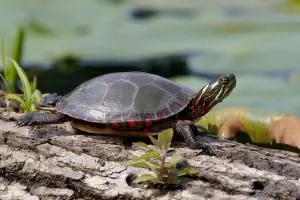
- Experience Level: Beginner
- Family: Emydidae
- Scientific Name: Chrysemys Picta Marginata
- Adult Size: 5 to 9 inches
- Lifespan: 25 to 50 years
- Average Price Range: $64 to $279
- Recommended Book: Painted Turtle care, behavior, diet, interacting, costs and health by Ben Team
The highly colorful Midland Painted Turtle has a body similar to a pond slider turtle. The shell is oval and smooth and has light or olive-green to black shades.
You will see some light red lines running along their “forearms” and yellow lines across their face from their mouths and nose. The neck part usually has red lines.
The Midland Painted Turtle’s eye also has a prominent yellow line behind them.
Females are bigger than males, but they have shorter tails. You can identify a male Midland Painted Turtle with its long front claws.
10. Spotted Turtle (Clemmys Guttata)
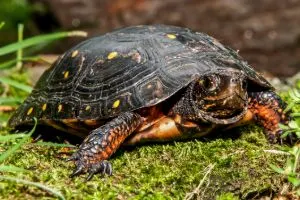
- Experience Level: Intermediate
- Family: Emydidae
- Scientific Name: Clemmys Guttata
- Adult Size: 5.6 inches
- Lifespan: 30 years
- Average Price Range: $199 to $349
- Recommended Books: BASICS – Ecology, Husbandry & Breeding Spotted & Wood Turtles by Andreas S. Hennig
The Spotted Turtle is easy to recognize. It has round yellow spots all over its black or brownish-black shell.
As of 2010, Spotted Turtles have been listed as an Endangered species. So make sure to give them a closer look when you spot some in Georgia.
Their life expectancy is over 25 years. Experts estimate that the species has suffered at least a 50% reduction in population.
This turtle type inhabits swamps, wet meadows, marshes, bogs, and small streams and feeds primarily on small live prey such as worms and tadpoles, but they also scavenge for fruits and algae.
Females mature between 7 to 13 years and reach a size of 3 inches to 4 inches, while males mature between 7 to 15 years and reach a size of 3 to a little less than 4 inches.
Females produce 1 or 2 clutches and lays 3 to 5 eggs and hatchlings are born after a 67-day incubation period.
Spotted turtles are available for trade-in limited quantities, and these are mostly captive-bred. Please only buy captive-bred species.
11. Eastern Chicken Turtle (Deirochelys Reticularia Reticularia)

- Experience Level: Expert
- Family: Emydidae
- Scientific Name: Deirochelys Reticularia Reticularia
- Adult Size: 4 to 6 inches on average
- Lifespan: 20 years
- Average Price Range: $199
- Where to buy: TheTurtleSource.com
Did you know that Chicken turtles were once traded in food markets in the southern United States? They got their common name chicken turtle because of the taste of their meat.
Now, the Eastern Chicken Turtle is one of three subspecies that includes the Western Chicken Turtle and Florida Chicken Turtle.
You can find all three of these species in the water systems of Georgia. Among the 3, The Eastern Chicken Turtle is duller in color. It has narrow brown or green lines on the shell, with a narrower color band on the rim.
Chicken Turtles are elongated and high-domed and have a netlike pattern on their rough, ridged carapace.
Their shell may have brown to olive colors with yellow to light brown patterns. You may see some black spots on their marginal scutes and their plastron is yellow, sometimes with a faded blotch on it.
One last cool little fact is that the two largest recorded Eastern Chicken Turtles were 7.9 inches and 10 inches long.
12. Florida Chicken Turtle (Deirochelys Reticularia Chrysea)

- Experience Level: Expert
- Family: Emydidae
- Scientific Name: Deirochelys Reticularia Chrysea
- Adult Size: 4 to 6 inches on average
- Lifespan: 20 years
- Average Price Range: $139
- Where to buy: TheTurtleSource.com
Compared to other Chicken Turtles, this turtle has more ornate and colorful netlike patterns on the shell and stripes on the head.
They have broad yellow or orange lines on their carapace and a wide color stripe on the rim. There are no markings on the plastron.
Adult female Florida Chicken Turtles grow much larger than other females of the subspecies.
Like the Eastern Chicken turtle, they have a larger domed shell which also happens to be weaker and thinner than other aquatic turtles.
You can find them inhabiting seasonal wetlands around Georgia, but probably not near any alligators since their shells won’t protect them too well.
13. Western Chicken Turtle (Deirochelys Reticularia Miaria)
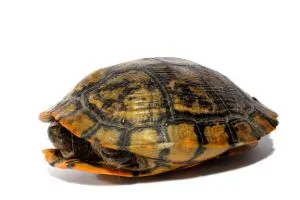
- Experience Level: Expert
- Family: Emydidae
- Scientific Name: Deirochelys Reticularia Miaria
- Adult Size: 4 to 6 inches on average
- Lifespan: 20 years
Among other Chicken Turtles, the Western Chicken has a flatter shell that is egg-shaped and rough with brown or olive color, has faint lines on its shell, and dark markings along its plastron seams.
They say it’s the only sub-species that have plastral markings, so that’s how you distinguish them from the Eastern and Florida Chicken Turtles. There are also no markings under the necks and chins of most adult Western Chicken Turtles.
Like other Chicken Turtles, this turtle has a long, striped neck, which is probably why some people call them American Snake Necks.
For their diet, wild Western Chicken Turtles are known to be carnivorous in their first year of life and to become more omnivorous as they grow.
14. Barbours Map Turtle (Graptemys Barbouri)
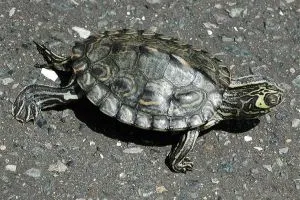
- Experience Level: Beginner
- Family: Emydidae
- Scientific Name: Graptemys Barbouri
- Adult Size: maximum female size at 13 inches, males at 5.2 inches on average
- Lifespan: longest at 31 years
Barbours Map Turtles are terrestrial, freshwater turtles and are native to Georgia, Florida, and Alabama.
In 2009, they were rated as the fourth-rarest Graptemys. IUCN lists the species as Vulnerable.
The species choose deeper and faster-flowing water systems compared to other turtle types of the same family.
They choose free-flowing rivers that are abundant in freshwater snails and have limestone bottoms. They also inhabit silty channels.
They are carnivorous and will feed on insects and snails. Captive bred turtles can be fed with crickets, fish, worms, fish, and aquatic plants besides snails.
A Barbours Map Turtle has black or dark brown skin and has yellow to green markings on its shell. Its head is broad and patterned with wide stripes on the top part of its neck. Its hind limbs and tail are also striped.
Its green to olive-green carapace is rough and highly domed and you can see a distinct vertebral keel and dark spines on each vertebral scute.
It has a yellow plastron with no markings, just a black border on each scute.
Females can grow three times the size of males, and they have wider heads than male ones.
Female Barbours Map Turtles reach maturity at 14 to 20 years, while males mature at 3 or 4 years. Females lay about 3 to 5 clutches in a year, with 7 to 10 eggs per clutch.
15. Common Map Turtle (Graptemys Geographica)
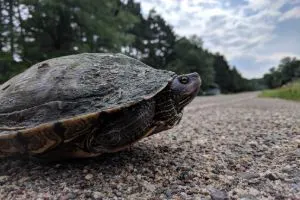
- Experience Level: Beginner
- Family: Emydidae
- Scientific Name: Graptemys Geographica
- Adult Size: females between 7 to 10.5 inches, males between 3.5 to 6.5 inches
- Lifespan: 20+ years
- Average Price Range: $89 to $129
- Where to buy: TurtleSource.com
- Recommended Book: Map Turtles and Diamondback Terrapins (Herpetology Series) by W.P. Mara
Common Map Turtles are also called Northern Map Turtles. They were said to be the second most common Graptemys in 2009.
They inhabit rivers and drainage systems, streams, lakes, and ponds. Just about wherever aquatic vegetation is abundant, and the water is deep with rocky or stony bottoms.
You can see them basking on fallen trees around Georgia’s waters feeding on mollusks and aquatic invertebrates.
Map turtles get their name from the map-like markings on their olive to grayish-brown shells. They have yellow or orange lines with dark borders. They have a broad carapace and a low keel and the plastron of adults is yellowish in color.
Common Map Turtles have dark olive or brown heads, necks, and limbs with green, yellow, and sometimes orangey stripes.
Most of them have an oval spot behind the eyes.
Males have narrower heads and longer front claws, thicker tails, more oval shells, and a more distinct keel. Their vent opens beyond the edge of the shell but female Common Map Turtles’ vents open up their carapace.
Females mature at 12 years and lay 2 clutches with 9 to 17 eggs per clutch.
They are omnivores and since females are larger, they eat larger prey than the males. They feed on clams, crayfish, and snails. Males eat smaller crustaceans and other aquatic insects.
16. Alabama Map Turtle (Graptemys Pulchra)

- Experience Level: Beginner
- Family: Emydidae
- Scientific Name: Graptemys Pulchra
- Adult Size: females at 7 to 10.74 inches, males at 3.5 to 5.11 inches
- Lifespan: 20+ years
- Recommended Book: Map Turtles and Diamondback Terrapins (Herpetology Series) by W.P. Mara
Common Map Turtles are found in large, fast-flowing creeks or rivers around Georgia.
Like other map turtles, Alabama Map Turtles inhabit areas where they can bask on fallen trees or brush piles.
IUCN lists the species as Near Threatened due to habitat destruction and the decline of the mature population.
This turtle type was considered the fifth rarest Graptemys in 2009.
Females mature at 14 years while males mature a little earlier from 8 to 10 years. Females lay 1 to 2 clutches with an average of 1 to 5 eggs.
Males generally feed on insects, and females will eat freshwater mussels and mollusks.
17. 3-Striped Mud Turtle (Kinosternon Baurii)

- Experience Level: Intermediate
- Family: Kinosternidae
- Scientific Name: Kinosternon Baurii
- Adult Size: males at 4 to 4.64 inches
- Lifespan: 50+ years
- Average Price Range: $59 to $119
3-Striped Mud Turtles are also called Striped Mud Turtle, 3-Lined Mud Turtle, and Lined Mud Turtle.
These turtles are a small type. They are easily recognized because of their three stripes that run laterally along the length of their carapace.
On rare occasions, you may find a 3-striped Mud Turtle with no stripes whatsoever.
These terrestrial turtles inhabit coastal waters, shrublands, forests, and inland wetlands.
They choose still or slow-flowing freshwater areas like ponds, swamps, streams, ditches, and canals.
The species is omnivorous and feeds on juniper leaves, algae, and cabbage palm seeds in the wild.
They have dark brown, tan, mahogany, or black color. They have olive to yellow plastron with two plastral hinges that provide protection.
The head and neck may have marbled patterns in some light-colored turtles. Usually, the head has two light-colored stripes, either broken or continuous.
Females mature once they reach 3 inches (around five years). They lay 3 to 6 clutches each year, with 2 to 3 eggs per clutch.
18. Eastern Mud Turtle (Kinosternon Subrubrum)
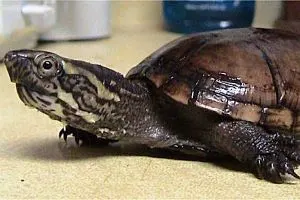
- Experience Level: Intermediate
- Family: Kinosternidae
- Scientific Name: Kinosternon Subrubrum
- Adult Size: 4.72 inches
- Lifespan: 23 years, max at 46 years
- Average Price Range: $59 to $119
Also known as the Common Mud Turtle, these turtles have a large lower shell (plastron), which has 2 movable hinges instead of one.
Their carapace is domed and usually has a brown, yellow, olive, or black color. The neck and head are often brown-colored, and you can see light stripes or mottling.
This species prefers shallow and soft bottoms with lots of vegetation. These turtles are not frequent baskers.
They inhabit still or slow-moving water systems. These turtles can also adapt to the salinity of salt marshes.
By nature, Common Mud Turtles are carnivores, but they can be omnivores.
These turtles mature at ages 4 to 8 years. They would be about 2.75 inches to 3.14 inches by this time.
Females produce 1 clutch with 1 to 8 eggs per clutch. It’s very rare for some females to produce 2 or 3 clutches.
Hatchlings come out in 100 days, and they measure between 1.8 cm to 2.3 cm.
19. Florida Mud Turtle (Kinosternon Subrubrum Steindachneri)

- Experience Level: Intermediate
- Family: Kinosternidae
- Scientific Name: Kinosternon Subrubrum Steindachneri
- Adult Size: 2.75 inches to 4.92 inches
- Lifespan: 20+ years
- Average Price Range: $179 to $395
- Where to buy: TheTurtleSource.com
Florida Mud Turtles look pretty much like the other Mud Turtles described in this list.
But this turtle type has a smaller bridge compared with Eastern Mud Turtles. And the males are bigger than their female counterparts.
Juveniles sometimes have three raised ridges (longitudinal keels).
Florida Mud Turtles likewise choose freshwater areas with slow currents. In Georgia, you may find them inhabiting areas that have sandy bottoms and lots of vegetation.
They are primarily carnivorous, feeding on fish, bloodworms, and clams. They will also feed on vegetation. Captive pets will feed on all these. You can also offer your pet turtle some green leafy vegetables along with turtle food pellets.
20. Mississippi Mud Turtle (Kinosternon Subrubrum Hippocrepis)
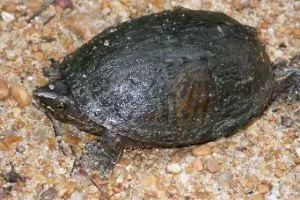
- Experience Level: Intermediate
- Family: Kinosternidae
- Scientific Name: Kinosternon Subrubrum Hippocrepis
- Adult Size: 3 inches to 4.75 inches
- Lifespan: 30+ years
The small-sized Mississippi Mud Turtle also has yellow stripes along the sides of its head and neck.
The upper shell is dark brown to black, and the lower shell is yellow with rich brown spots.
Males have a claw-like tail end. These turtles can give off a strong, musky odor when they feel threatened.
You can spot these turtles near swamps or in lakes and canals of Georgia. They wade through shallow waters.
You won’t find them much in flowing rivers. These mud turtles are the ones you often see on the roads and highways.
Mississippi Mud Turtles feed on rooted aquatic vegetation and aquatic insects. They eat mussels, snails, and crayfish, among other amphibians.
Females are sexually mature at 6 years. They lay between 1 to 6 eggs and have 1 to 3 clutches each season.
They prefer laying eggs in dry, sandy soil. After 105 days, the hatchlings are born.
21. Diamondback Terrapin (Malaclemys Terrapin)
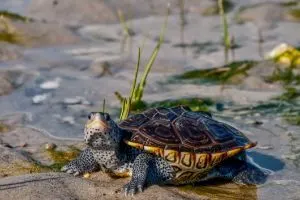
- Experience Level: Beginner to Intermediate
- Family: Emydidae
- Scientific Name: Malaclemys Terrapin
- Adult Size: females at 7.91 inches, males at 5.24 inches, longest female at 12.6 inches
- Lifespan: 50+ years
- Average Price Range: $249 to $499
- Recommended Book: Map Turtles and Diamondback Terrapins (Herpetology Series) by W. P. Mara
There are 7 subspecies of Diamondback Terrapins.
You have the Northern Diamondback Terrapin, Carolina Diamondback Terrapin, Texas Diamondback Terrapin, Ornate Diamondback Terrapin, Mississippi Diamondback Terrapin, Mangrove Diamondback Terrapin, and Eastern Florida Diamondback Terrapin.
These terrapins inhabit coastal waters and go inland through estuaries. You also see them in brackish waters and salt marshes.
Diamond Terrapins also seek fresh water for drinking and general health. Hatchlings to juveniles are semi-terrestrial for up to 3 years.
The species was in danger of extinction in the early 1900s because of commercial harvesting for their meat.
The Malaclemys Terrapin was last assessed as Vulnerable because of habitat destruction and other threats Nesting populations declined by 55% from 1998-2017.
In Georgia, roadkill and commercial crabbing on tidal creeks are a cause of population decline.
The Diamond Terrapin has a black carapace with black spots on its gray skin. It is one of the darkest turtles you can find.
It is unique-looking for its knobbed keel and its higher shell with a deeper bridge.
This turtle has a white lip. Its skull is elongated and has a bony temporal arch. The hind legs are large, and its toes are webbed.
Males are much smaller than females. They weigh only up to 1.1 pounds, while females can weigh as much as 5.5 pounds.
This turtle type is the only species to have much bigger females than males.
22. Eastern River Cooter (Pseudemys Concinna)
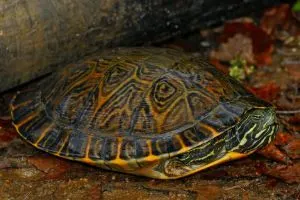
- Experience Level: Intermediate
- Family: Emydidae
- Scientific Name: Pseudemys Concinna
- Adult Size: females at 16 inches, males at 13 inches
- Lifespan: 40 to 44 years
- Average Price Range: $77 to $139
- Recommended Book: Aquatic Turtles: Sliders, Cooters, Painted, and Map Turtles (Reptile Keeper’s Guide) by R.D. Barlett
River Cooters are pond turtles. They are widespread and abundant locally.
They choose medium to large rivers that have clear water and aquatic vegetation. They also inhabit swamps, springs, and farm ponds.
These turtles frequent land areas to bask and nest. The River Cooter feeds mostly on aquatic plants. It is an herbivore.
Males are sexually mature at 6 years, while females mature at 13 to 24 years. They lay 1 to 6 clutches with 15 eggs per clutch. In 86 days, hatchlings are born. Hatchlings measure a little over an inch and weigh about 5.2 grams at the least.
They are bright green and will have some light markings. These markings will darken with age. Adult ones have long, flat, and oval shells that have light and dark brown spots.
Some have green or yellow patterns on the shell. Others have brown-to-black patterns.
Mature River Cooters can weigh up to 11 pounds and measure as long as 17 inches. Males have flatter shells and longer foreclaws than females.
The shells of River Cooters are known to adapt to their habitat.
Their shells flatten depending on how strong the current is in their habitat. Flatter shells are often weaker shells than domed ones.
23. Florida Cooter (Pseudemys Floridana)

- Experience Level: Intermediate
- Family: Emydidae
- Scientific Name: Pseudemys Floridana
- Adult Size: 9 to 13 inches
- Lifespan: 20+ years
- Recommended Book: Aquatic Turtles: Sliders, Cooters, Painted, and Map Turtles (Reptile Keeper’s Guide) by R.D. Barlett
Like other cooters, the Florida Cooter chooses swamps, backwaters, and large wetlands as habitat.
But unlike the River Cooter, this turtle type does not prefer fast-moving currents, even though they are good swimmers. They prefer still waters.
On land, you may find them basking together in groups and even stacking.
Florida Cooters have dark, flat shells with yellow or orange spots and markings. Their plastron is plain, and there are hollow oval markings on their marginal scutes.
These turtle types have yellow-orange stripes on their head. And they have flat chins.
Florida Cooters look quite similar to Peninsula Cooters and River Cooters. They sometimes mate with River Cooters.
For your pet Florida Cooter’s tank, you can deepen the waters. However, you need to provide enough land for them to bask and explore.
Common to cooters, Florida Cooters are primarily herbivorous and feed mostly on aquatic plants.
But they will occasionally eat insects, particularly the juveniles. Keep this in mind as you plan the diet of your growing pet cooter.
24. Florida Red-Bellied Cooter Turtle (Pseudemys Nelsoni)
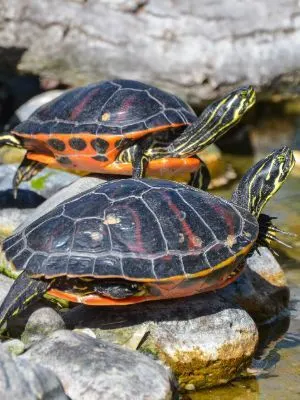
- Experience Level: Intermediate
- Family: Emydidae
- Scientific Name: Pseudemys Nelsoni
- Adult Size: 12 inches, largest female at 14.77 inches
- Lifespan: 26 years, 33 years longest recorded
- Recommended Book: Aquatic Turtles: Sliders, Cooters, Painted, and Map Turtles (Reptile Keeper’s Guide) by R.D. Barlett
Florida Red-Bellied Turtles are distinct for the red color on their ventral shell, which is vivid in juveniles.
As they turn adults, the red color may fade or lighten. Their head, arms, legs, and tails have yellow stripes. There may be alternating black stripes on the legs.
The dark brown shell is deep and domed. It is about 1.5 times wider than its height. The carapace has yellow edges and a red marking on the first three costal scutes. It may be Y-shaped.
They have a black plastron which may or may not have spots. The population of Florida Red-Bellied Cooters is stable in Georgia. You’ll spot many of them in Okefenokee Swamp, Southern Georgia.
This turtle type may be the most dominant freshwater turtle population.
Pretty much similar to other cooters, this freshwater turtle inhabits still waters with lots of vegetation. You’ll find them in lakes, marshes, ditches, spring runs, and streams.
They seem to dislike sandy substrates and choose humid areas. These bask during the heat of the day.
Florida Red-Bellied Cooters weigh about 8.8 pounds. Females mature from 7 years. Males mature earlier at 3 years onwards.
On average, females lay 3 to 6 clutches with 14 eggs per clutch. Hatchlings come out at 3.2 cm.
Their nests are vulnerable to various threats. They also sometimes lay eggs in alligator nests.
At other times, the nests get infested with fire ants. The mortality rate for hatchlings killed by fire ants is 70%.
25. Loggerhead Musk Turtle (Sternotherus Minor Minor)
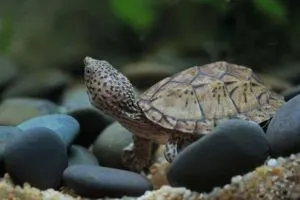
- Experience Level: Beginner
- Family: Kinosternidae
- Scientific Name: Sternotherus Minor Minor
- Adult Size: 2.95 inches to 4.52
- Lifespan: longest recorded is 23 years in captivity and 21 years in the wild
- Average Price Range: $59 to $99
You can find Loggerhead Musk Turtles throughout most of Georgia, particularly on the Atlantic side of the Appalachians.
It is one of two subspecies of Sternotherus Minor. The other is the Stripe-Necked Musk Turtle (S. Minor Peltifer).
Loggerhead Musk Turtles inhabit freshwater habitats, mostly inland. They choose rocky or sandy bottoms with fallen trees or snags.
You can see them in spring runs, creeks, rivers, swamps, and sinkhole ponds. They live in shallow water, but you can find some in deep waters of up to 13 meters.
Loggerhead Musk Turtles often hide underwater in rock crevices, crayfish burrows, or submerged logs. They can stay under for 60 hours if the water is aerated.
Musk Turtles are carnivorous. They feed on aquatic invertebrates as juveniles. As they turn adults, they prefer freshwater clams and snails. These turtles hunt for food more often at night.
Their carapace color comes in dark brown to orange colors, with darker borders. Their skin can be brown or spotted gray.
They have webbed feet. Males have darker-colored heads and thicker tails.
The longest female measured at 5.7 inches. And the longest male was measured at 4.72 inches.
Males are mature at 3 to 6 years. By this time, they measure around 2.16 inches to 2.36 inches. Females mature at 5 to 8 years and would be around 2.75 inches to 3.14 inches.
Loggerhead Musk Turtles are rarely aggressive. They may bite only when they sense danger. A known prey of these turtles is the Alligator Snapping Turtles (Macrochelys Temminckii).
26. Stripe-Necked Musk Turtle (Sternotherus Minor Peltifer)

- Experience Level: Beginner
- Family: Kinosternidae
- Scientific Name: Sternotherus Minor Peltifer
- Adult Size: 3 to 4 inches, largest recorded at 4.6 inches
- Lifespan: 20 years
Stripe-necked musk turtle is a subspecies of Sternotherus Minor, along with Loggerhead Musk turtles. They are sometimes confused with Sternotherus Odoratus, which has a dark brown carapace.
Striped-necked musk Turtles have strongly arched shells. The vertebral scute overlaps the scute behind it.
The anterior vertebral scute is shaped like a dagger. It has a square-shaped pectoral scute.
They have yellow-striped markings on the necks. The beak of their lower jaw is curved upward.
The shell is brown to olive-brown, which may or may not be spotted. They have yellowish plastron with dark to dark brown spots on the scutes.
They have brown to grayish-brown skin with yellow spots on the legs.
Males are shorter than females by at least .4 cm carapace length. Like Loggerhead Musk Turtles, these males have darker heads than the female ones.
Adult males have a spine on the end of the tail, with a scaly patch behind the knees of the back legs.
One interesting thing about Stripe-Necked Musk Turtles is that they can remain absolutely still for 24 hours at a time. They do this, especially at night.
Stripe-necked musk turtles mostly feed on insects such as beetles and stoneflies, including other aquatic prey such as crayfish and clams. They may also scavenge for dead fish and eat algae.
Unlike its other co-subspecies, Loggerhead Musk Turtles, Stripe-Necked Musk Turtles hunt for food in the mornings. And they tend to spend a lot of their time hunting for food.
27. Common Musk Turtle (Sternotherus Odoratus)
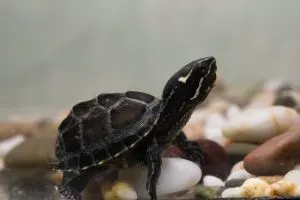
- Experience Level: Beginner
- Family: Kinosternidae
- Scientific Name: Sternotherus Odoratus
- Adult Size: 2.75 to 3.93 inches, maximum at 5.51 inches
- Lifespan: 20 to 30 years in the wild, 54+ years in captivity
- Average Price Range: $59 to $149
The Common Musk Turtle is also called the Eastern Musk Turtle or Stinkpot Turtle. These turtles are widespread and adaptable to a variety of habitats.
They choose flowing and standing water systems. But they don’t do well in saline water. You’ll see them in shallow streams, ponds, and clear lakes around Georgia.
Common Musk Turtles have a smooth and oval carapace, which is either brown or black. They have dark-olive to black skin.
These turtles are marked with two yellow lines running from the snout to their neck, and one on either side of their eye.
There are barbels on their chin and the underside of their elongated necks. They are unique for having barbels on the throat. No other musk turtle has that feature.
The species is primarily carnivorous but can also be omnivores. They prefer mollusks.
These turtles are sexually mature between 2 to 7 years. Mating happens underwater. Communal nesting is observed among Common Musk Turtles. They make their shallow nests at the water’s edge hidden under dead leaves or logs.
Instead of swimming as other turtles do, they walk on the bottom of ponds and streams to forage for food.
They also release a strong, foul liquid from their musk glands as a defensive tactic in times of danger. Hence, they are also called Stinkpot Turtles.
28. Gulf Coast Box Turtle (Terrapene Carolina Major)
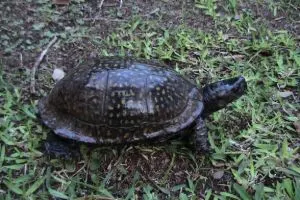
- Experience Level: Beginner
- Family: Emydidae
- Scientific Name: Terrapene Carolina Major
- Adult Size: 8 inches
- Lifespan: 20+ years
- Average Price Range: $229 to $449
- Recommended Book: Box Turtles (Complete Herp Care) by Tess Cook
The Gulf Coast Box Turtle is the largest turtle type among all Common Box Turtles. You’ll see them mostly along the Gulf Coast, but they also inhabit Georgia’s water systems.
It prefers wet conditions in swamps and marshes. They like shallow waters.
They have a domed shell that grows up to 8 inches long.
The shell is usually dark brown to black and has yellow stripes or spots. The plastron may be solid-colored or spotted.
Females generally have brown eyes, while males have brown or red eyes. Their skin is brown, and males may have colored scales on the neck and legs.
They have 3 or 4 toes on each back leg. Older males sometimes have a white mark that resembles a mustache or sideburns.
They don’t hibernate much, only when the temperature drops very low. So they can be pretty active all year round.
29. Three-Toed Box Turtle (Terrapene Carolina Triunguis)
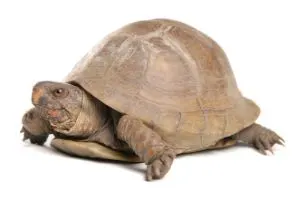
- Experience Level: Beginner
- Family: Emydidae
- Scientific Name: Terrapene Carolina Triunguis
- Adult Size: 5 inches, longest at 7 inches
- Lifespan: 70 years
- Average Price Range: $249 to $449
- Recommended Book: Box Turtles (Complete Herp Care) by Tess Cook
These turtles are sometimes called Eastern Box Turtles, but they are two different subspecies.
Like other box turtles, they are relatively small and have a high-domed shell. Most have a thin ridge on the center of the carapace.
The plastron is light-colored and spotless. It is shorter than the carapace and has anterior and posterior hinges. These close to hide the turtle’s body completely.
Their toes have no webbing, and they have short limbs. Adults are mostly solid brown, but juveniles have spots on the carapace.
Some adults are seen to have light-colored markings on their shells. Three-toed Box Turtles have bright multi-colored heads that come in orange, red, and white mixes.
Like Gulf Coast Box Turtles, they have red eyes while the females may have green eyes besides the usual brown.
These species are sometimes confused with the Ornate Box Turtle because they have similar-looking bodies.
But three-toed box turtles have three toes on their hind feet, while Ornate Box Turtles have four.
These turtles are diurnal. In the wild, they are observed to be active from April to October. They sometimes walk on highways in the late afternoons, especially on wet days.
Females can store sperm for years, so they do not need to mate yearly. They produce 1 to 6 clutches.
They eat insects, earthworms, and crickets. Tomatoes, melons, and other vegetation become a preference as they age. Pet owners say they also eat eggs, waxworms, and even wet dog food.
30. Eastern Box Turtle (Terrapene Carolina Carolina)
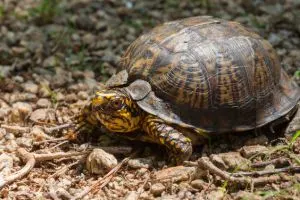
- Experience Level: Beginner
- Family: Emydidae
- Scientific Name: Terrapene Carolina Carolina
- Adult Size: females at 9.25 inches, males at 7.28 inches
- Lifespan: 25 to 35 years
- Average Price Range: $269 to $359
- Recommended Book: Box Turtles (Complete Herp Care) by Tess Cook
The Eastern Box Turtle has been adopted as the official reptile of the State of North Carolina and Tennessee.
This turtle type is one of 6 subspecies of Terrapene Carolina. Four are found in the US, and that includes the Gulf Coast Box Turtle, Florida Box Turtle, and Eastern Box Turtle.
It is listed as vulnerable due to the degradation of habitat and the decline of the mature population.
Terrapene c. Carolina, in particular, reaches about 5.9 inches by 3.93 inches in size. They have orange or yellow markings on their brown shell. And they have four toes on their hind feet.
In Georgia, you’ll see them in shrubby grasslands, open broadleaf forests, streams, marshy meadows, palmetto thickets, and other areas with vegetation.
They are omnivorous and like to feed on mushrooms, plant leaves, flowers, fruits, and stems. They will also eat earthworms, snails, and slugs.
These become sexually mature at 5 to 6 years in males and between 7 to 8 years in females when they reach 3.5 inches long.
Females produce 1 to 2 clutches at an average of 3 to 5 eggs per year. A lot of females do not lay eggs yearly. Hatchlings incubate for 73 days on average and come out at about 3 cm. long.
31. Florida Box Turtle (Terrapene Carolina Bauri)

- Experience Level: Beginner
- Family: Emydidae
- Scientific Name: Terrapene Carolina Bauri
- Adult Size: 4.3 to 7.09 inches
- Lifespan: 20+ years
- Average Price Range: $224 to $449
- Recommended Book: Box Turtles (Complete Herp Care) by Tess Cook
The Florida Box Turtle usually reaches 4.3 by 3.14 inches. They have bright yellow lines that scatter on their dark brown carapace.
The plastron and its head have also lines. These have three toes on their rear feet.
Box turtles are known to mate between their subspecies. Mating occurs from April until October.
The females can keep laying eggs for up to four years after only one successful mating. They lay an average of 4 to 5 eggs.
Box turtles are said to live beyond 100 years in the wild and 40 years in captivity.
Like other box turtles, Florida Box Turtles are active in the cool mornings and after rain.
When the hot sun intensifies, they hide under leaves and logs, or in mud and animal burrows.
You might also see them in shallow pools or puddles cooling themselves.
In colder weather, they bask in the sun for warmth and may forage all day.
These omnivores look for snails, insects, slugs, worms, fish, and dead animals. They also eat fruits, roots, and flowers.
32. Cumberland Slider (Trachemys Scripta Troostii)
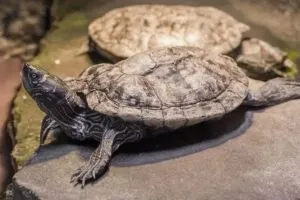
- Experience Level: Intermediate
- Family: Emydidae
- Scientific Name:
- Adult Size: 5 to 8 inches
- Lifespan: 30 years
- Average Price Range: $29 to $59
- Where to buy: Turtlesource.com
- Recommended Book: Aquatic Turtles: Sliders, Cooters, Painted, and Map Turtles (Reptile Keeper’s Guide) by R.D. Barlett
The small semi-aquatic Cumberland Slider Turtle is sometimes called the Cumberland Turtle or Troost’s Turtle.
This turtle is quite similar to its co-subspecies, the Red-Eared Slider Turtle.
But Cumberland Slider turtles are lighter colored. And they are more yellow in color.
They also do not have the red ears that are unique to the Red-Eared Slider.
In the wild, they choose quiet waters with muddy bottoms as habitat. You’ll see them in ponds, streams, and lakes around Georgia.
They prefer organic and vegetated surroundings that they can feed on and hide under.
Some believe these were first found living in Cumberland River Valley.
These turtles have oval shells that are green or olive-brown with yellow lines or stripes. Their shell is keeled.
Their plastron is yellow with yellow stripes or dark spots. It is smaller than the carapace and hingeless.
The marginals have spots on the bottom.
They have brown skin, which also has yellow stripes running all over it, including the front legs.
Males are smaller than females, and they have long claws on the front legs. Females have a more domed shell.
Cumberland Sliders are known to quickly slide into the water when they sense danger.
They also bask in groups. You may even see them basking on top of each other.
33. Yellow-Bellied Slider (Trachemys Scripta Scripta)

- Experience Level: Intermediate
- Family: Emydidae
- Scientific Name: Trachemys Scripta Scripta
- Adult Size: 5 to 8 inches, longest at 1 foot
- Lifespan: 25+ years
- Average Price Range: $28 to $77
- Recommended Book: Aquatic Turtles (Complete Herp Care) by David T. Kirkpatrick
Yellow-Bellied Sliders are widely abundant. You may spot a lot of these sliders around Georgia basking come springtime or fall. They are congregatory, so you can see them on logs or rocks in groups.
They inhabit sinkholes, rivers, sloughs, lakes, and bay areas. They often move from habitat to habitat via land.
This turtle type has a brown or olive-green shell with vertical bands.
You can see a yellow patch on the side of its head. It has a round lower jaw.
The Yellow-Bellied Slider also has a yellow plastron with narrow yellow stripes. It may or may not have rounded markings.
The front legs also have narrow yellow stripes.
The Yellow-Bellied Slider is semiaquatic. It stays underwater for long periods and feeds on floating vegetation.
They also move on land to lay eggs or in search of more suitable or vegetated habitat.
Juvenile sliders feed on aquatic insects, tadpoles, and dead fish or other meat.
As adults, they can also feed on lots of vegetation such as algae, leaves, fruits, seeds, and roots. But they regularly feed on larger invertebrates, small fish, and frogs.
Yellow-bellied sliders are sexually mature when males reach 4 to 5.5 inches in length and when females reach 6.5 inches in length.
34. Red-Eared Slider (Trachemys Scripta Elegans)
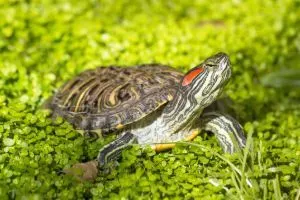
- Experience Level: Intermediate
- Family: Emydidae
- Scientific Name: Trachemys Scripta Elegans
- Adult Size: 6 to 8 inches
- Lifespan: 20 to 30 years
- Average Price Range: $29 to $59, albinos at $279 to $369
The Red-Eared Slider comes by many names. It is also called the Red-Eared Terrapin, Red-Eared Slider Turtle, Red-Eared Turtle, Slider Turtle, and Water Slider.
Like other slider turtles, the Red-Eared Slider chooses soft-bottomed habitats with temperate, shallow water and slow currents. They look for areas that are abundant in vegetation and get good sunlight.
The Red-Eared Slider has a green shell with bright yellow stripes. Its most distinguishing feature is its red ears and a red patch behind both eyes. It may also have a red spot on the top of its head.
Skin and plastron markings differ by subspecies.
Cumberland Sliders have yellow and black lines on the legs and posteriors. They have yellow markings on the neck and behind the eyes.
Yellow-bellied sliders have more yellow and black lines on the neck and limbs that are thinner and vertical.
The yellow markings near the eyes are also vertical and rectangular. And they have two black spots on their plastrons.
As for the Red-Eared Slider, they also have similar-looking lines on their back limbs, but the streaks behind their eyes are bright red and lines up horizontally.
These excellent swimmers spend a lot of time underwater. But they often bask too.
These turtles are omnivorous and eat varying types of plant and animal matter. Captive pets may be given krill, commercial turtle food blends, and worms.
Tortoises in Georgia
35. Gopher Tortoise (Gopherus Polyphemus)

- Family: Testudinidae
- Scientific Name: Gopherus Polyphemus
- Adult Size: 10 inches, maximum at 15 inches
- Lifespan: 50 to 70 years in the wild, 86 years in captivity
Gopher Tortoises are terrestrial reptiles exclusive to the southeastern US. The majority of them are in Florida, and you can spot small congregations in Georgia.
They inhabit dry and sandy soils with plenty of low-growing plants. You’ll see them in coastal dunes, sandhills, scrubs, and grasslands.
These turtles build underground burrows 2 meters (roughly 6 feet) deep, which they use for refuge against fires, extreme heat, and predators.
They can grow as heavy as 12 pounds. You can identify a Gopher Tortoise by its unwebbed and flattened hind feet. Their forelimbs look like shovels, which they use conveniently for digging.
They have a brown oblong shell, which is sometimes gray or tan colored. Their plastron is dull yellow or pale brown. It is unhinged.
Young tortoises have visible growth rings on the shell, but these fade over time.
They are herbivorous reptiles. They eat leaves, stems, fruits, roots, tubers, and wiregrass. Low vegetation mostly supplies their need for water. They may also eat some worms and insects.
Both male and female Gopher Tortoises mature as early as 9 years, and they are quite similar in size and appearance.
The shell of females is a bit larger. Their plastrons are flatter, while the plastron of males is concave. Females lay a single clutch per season. And one clutch has six eggs on average. After 80 to 90 days, the hatchlings arrive.
IUCN lists the species as Vulnerable, while US Fish, and Wildlife Service lists them as Threatened.
Sea Turtles in Georgia
36. Loggerhead Sea Turtle

- Family: Cheloniidae
- Scientific Name: Caretta caretta
- Common Name: Loggerhead
- Adult Size: between 31 to 43 inches
- Weight: 165 to 330 pounds
- Lifespan: 45 years on average
- Conservation Status: Vulnerable Worldwide
- Habitat: open sea or shallow coastal waters of Georgia
- Recommended Book: Loggerhead Sea Turtles by Alan B. Bolten
- Clutch Size: 1 to 6 clutches, 50 to 170 eggs per clutch (120 eggs on average)
- Food: Carnivorous; sea snails, mussels, corals, sea anemones, fish, squid, sea urchins, sea sponges, sea anemones
- Appearance: Hard-shelled, patchy reddish-brown or yellow-orange upper shell, with pale yellow lower shells
This is the largest hard-shelled sea turtle. The exceptionally large ones can weigh as heavy as 440 pounds.
Among the 5 sea turtles found in Georgia, the Loggerhead is the only type that regularly nests there. Some of its nesting grounds are on the islands of Sea, Jekyll, Sapelo, and Ossabaw.
Like other sea turtles, the Loggerhead spends most of its life in the ocean. It comes to shore only to mate and nest.
Females can reproduce by 15 years. And they lay eggs every 2 or 3 years.
They usually nest on the same beach every time, and their hatchlings seem to likewise nest on the same beach as they were born.
Georgia is home to 1,300 nests each year, but the largest nests are found in Florida.
These turtles often fall prey to boat strikes and can get entangled in fishing nets used by commercial fisheries, highlighting the need for protective measures along the coast of Georgia and the Atlantic Ocean.
If you’re interested in finding out more, check out our post on Loggerhead Turtles.
37. Hawksbill Sea Turtle (Eretmochelys imbricate)

- Family: Cheloniidae
- Scientific Name: Eretmochelys Imbricata
- Adult Size: 30 to 35 inches
- Weight: between 101 to 154 pounds
- Lifespan: 30 to 50 years
- Conservation Status: Critically Endangered
- Habitat: open waters, coastal reefs, lagoons, rocky areas, mangrove estuaries,
- Clutch Size: 4 to 5 clutches, 160 eggs per clutch
- Food: Carnivore; sponges, anemones, squid, shrimp
- Appearance: beautiful orange, yellow, or brown shell; narrow head, pointed beak, elliptical and bony carapace with no ridges
This turtle is named Hawksbill because of its narrow and pointed beak. Its shell also has a striking pattern of overlapping scales that look serrated on the edges.
Hawksbills are important to the health of our marine ecosystem. They feed on sponges, extracting them from the coral reefs.
Their sponge diet makes their meat toxic to humans. Eating Hawksbill Sea Turtle meat can make someone very ill or even cause death.
These tropical turtles are hunted for their beautiful shell. Many others are injured or killed by vessel strikes. They also die from ingesting plastic pieces or debris.
You can learn more about the endangered Hawksbill Sea turtle here.
38. Kemp’s Ridley Sea Turtle (Lepidochelys kempii)

- Family: Cheloniidae
- Scientific Name: Lepidochelys Kempii
- Common Name: Also called Atlantic Ridley Sea Turtle
- Adult Size: 24 inches
- Weight: 77 to 100 pounds
- Lifespan: 50 years
- Conservation Status: Critically Endangered
- Habitat: aquatic; shallow and sandy or muddy coastal areas
- Recommended Book: The Biology of Sea Turtles by Peter L. Lutz,
- Clutch Size: 1 to 3 clutches, 110 eggs per clutch
- Food: carnivore; crabs, squid, shrimp, jellyfish, will eat seaweed
- Appearance: small size, triangular head, broad shell, creamy white plastron and light gray to olive carapace, strong, ridged jaws
The Kemp’s Ridley Sea Turtle is named after its discoverer, Richard Kemp.
Kemp’s Ridleys are the only sea turtles that nest routinely in the daytime. And they nest a lot more than other species (1 to 3 years).
They are also distinct (only similar to Olive Ridleys) for their practice of nesting in large synchronized groups, called arribadas. Their hatchlings have dark colors but adults turn grayish-green color with pale yellow bottom shells.
The species reach sexual maturity much earlier than other turtles. They become sexually mature at 10 to 15 years of age.
This page tells your more about Kemp’s Ridley sea turtles, the rarest and smallest of all sea turtles.
39. Green Sea Turtle (Chelonia mydas)

- Family: Cheloniidae
- Scientific Name: Chelonia mydas
- Common Name: Also called Green Turtle, Pacific Green Turtle
- Adult Size: 31 to 47 inches (largest found was 5 feet)
- Weight: 150 to 400 pounds ( heavies at 871 pounds)
- Lifespan: up to 80 years in the wild
- Conservation Status: Endangered
- Habitat: mostly aquatic, open sea and along coastal areas to feed
- Recommended Book: Sea Turtles: A Complete Guide to Their Biology, Behavior, and Conservation by James Spotila
- Clutch Size: 1 to 3 clutches, 100 to 120 eggs per clutch
- Food: herbivore; plants, sea grass, seaweed
- Appearance: green-colored cartilage and body fat, creamy plastron, smooth and high-domed shell
This turtle is the only sea turtle that eats only plants. It is a herbivore. The greenish color of this turtle’s cartilage and fat is influenced by its plant diet.
Green Sea Turtles graze the seagrass bed and keeps it productive and healthy. This sea turtle also feeds on algae.
Green Turtles are unique for having a single pair of scales in front of their eyes. Other sea turtles have two pairs.
The Pacific Green Turtles are different in color. They have dark grey to black carapace.
People hunt these turtles for their meat. Others use these turtles for leather. Check out our page on the Green Sea Turtle to know more about them.
40. Leatherback Sea Turtle (Dermochelys coriacea)

- Family: Cheloniidae
- Scientific Name: Dermochelys coriacea
- Common Names: Also called Leathery Turtle, Lute Turtle, the luth
- Adult Size: 4.5 to 6 feet
- Weight: from 1,200 to 1,400 pounds (1,000 pounds on average)
- Lifespan: 30 years or more
- Conservation Status: Vulnerable
- Habitat: mostly aquatic, open and deep sea,
- Recommended Books: Leatherback Sea Turtles by Rebecca E. Hirsch, Adventures of Leatherback by James C. Boland
- Clutch Size: 3 to 10 clutches, 100 eggs per clutch
- Food: invertebrates, soft-bodied prey like salps and jellyfish
- Appearance: large, flatter turtle; dark, rubbery shell with 7 narrow ridges extending at their back; has flippers
The largest and most active sea turtle is the Leatherback Turtle. It can travel farther and deeper than any other sea turtle.
It is a strong swimmer that can stay underwater for 85 minutes before coming up for air.
Georgia records less than 10 nests per year, and egg collecting contributes to their population’s decline. Many of these endangered turtles also die from plastic bag ingestion.
There’s so much more to know about the amazing Leatherback Sea Turtle here.
Conclusion
As you just saw there are 40 types of turtles in Georgia all from varying species including freshwater species, land turtles, and even sea turtles.
Some of these can make great pets, while others will not and are not available for purchase either.
We hope we’ve increased your interest and excitement in exploring Georgia’s turtles. If you know of other turtles in the state, why not leave us a comment below?
And if you have some experiences to share about caring and observing one of these turtles, we’d love to hear about your stories here!
Other nearby states

Christopher Sanchez
Monday 23rd of August 2021
Bog turtles dont weigh 300lbs as your list states
Robert
Sunday 15th of August 2021
Had no idea so many indigenous species! Very informative